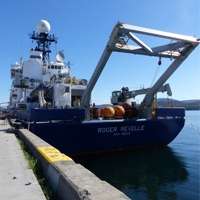Everyone has seen TV footage of surfers taking their lives into their hands in massive surf at Margaret River or Oahu in Hawaii, where waves can tower to six metres and produce solid walls of water and long pipelines.
But few people know that undersea waves are even bigger, often as tall as skyscrapers, and play an important role in ocean mixing and the transport of sediments and nutrients.
An environmental engineer from The University of Western Australia is participating in an international study of undersea waves off the coast of Tasmania, potentially a global hotspot for deep tidal mixing.
Associate Professor Nicole Jones and her PhD student Tamara Schlosser will spend most of February on board the 85m US research vessel the Roger Revelle where they will work with scientists from the Scripps Institution of Oceanography, UC San Diego, Oregon State University and University of Alaska.
In seas close to where the Sydney to Hobart yacht race is run every year, they will study the tidal waves that are generated off New Zealand's south coast and break on the Tasmanian continental shelf. Some of the waves are up to 240km long and impact not only the ocean ecosystem but also the Earth's climate.
By better understanding these internal waves, the scientists hope to learn more about the effects of the deep-sea turbulence and to improve global climate models.
Associate Professor Jones, who has conducted similar studies off WA's North West Shelf, said there was still a lot more to be discovered about internal waves, which can affect the safe operation of the oil and gas industry and ecosystem management.
Associate Professor Jones said she and Ms Schlosser would be busy at sea from 6 February deploying their moorings, analysing the data received from the profiling instruments and processing water samples - and hoped they wouldn't need their seasickness medication.
More information: For more information, see: scripps.ucsd.edu/projects/ttide/
Provided by University of Western Australia























